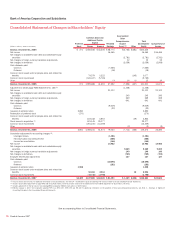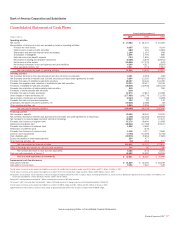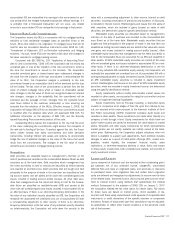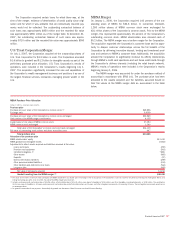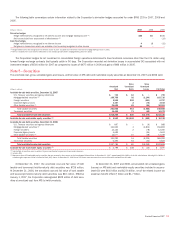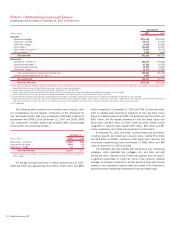Bank of America 2007 Annual Report Download - page 127
Download and view the complete annual report
Please find page 127 of the 2007 Bank of America annual report below. You can navigate through the pages in the report by either clicking on the pages listed below, or by using the keyword search tool below to find specific information within the annual report.Level 1
Quoted prices in active markets for identical assets or
liabilities. Level 1 assets and liabilities include debt and
equity securities and derivative contracts that are traded in
an active exchange market, as well as certain U.S. Treas-
ury securities that are highly liquid and are actively traded
in over-the-counter markets.
Level 2
Observable inputs other than Level 1 prices, such as
quoted prices for similar assets or liabilities; quoted prices
in markets that are not active; or other inputs that are
observable or can be corroborated by observable market
data for substantially the full term of the assets or
liabilities. Level 2 assets and liabilities include debt secu-
rities with quoted prices that are traded less frequently
than exchange-traded instruments and derivative contracts
whose value is determined using a pricing model with
inputs that are observable in the market or can be derived
principally from or corroborated by observable market
data. This category generally includes U.S. Government
and agency mortgage-backed debt securities, corporate
debt securities, derivative contracts, residential mortgage
and loans held-for-sale.
Level 3
Unobservable inputs that are supported by little or no
market activity and that are significant to the fair value of
the assets or liabilities. Level 3 assets and liabilities
include financial instruments whose value is determined
using pricing models, discounted cash flow methodologies,
or similar techniques, as well as instruments for which the
determination of fair value requires significant manage-
ment judgment or estimation. This category generally
includes certain private equity investments, retained
residual interests in securitizations, residential MSRs,
asset-backed securities (ABS), highly structured or long-
term derivative contracts and certain collateralized debt
obligations (CDO) where independent pricing information
was not able to be obtained for a significant portion of the
underlying assets.
For more information on the fair value of the Corporation’s financial
instruments see Note 19 – Fair Value Disclosures to the Consolidated
Financial Statements.
Income Taxes
The Corporation accounts for income taxes in accordance with SFAS
No. 109, “Accounting for Income Taxes” (SFAS 109) as interpreted by FIN
48, resulting in two components of income tax expense: current and
deferred. Current income tax expense approximates taxes to be paid or
refunded for the current period. Deferred income tax expense results from
changes in deferred tax assets and liabilities between periods. These
gross deferred tax assets and liabilities represent decreases or increases
in taxes expected to be paid in the future because of future reversals of
temporary differences in the bases of assets and liabilities as measured
by tax laws and their bases as reported in the financial statements.
Deferred tax assets are also recognized for tax attributes such as net
operating loss carryforwards and tax credit carryforwards. Valuation allow-
ances are then recorded to reduce deferred tax assets to the amounts
management concludes are more-likely-than-not to be realized.
Under FIN 48, income tax benefits are recognized and measured
based upon a two-step model: 1) a tax position must be more-likely-
than-not to be sustained based solely on its technical merits in order to be
recognized, and 2) the benefit is measured as the largest dollar amount of
that position that is more-likely-than-not to be sustained upon settlement.
The difference between the benefit recognized for a position in accordance
with this FIN 48 model and the tax benefit claimed on a tax return is
referred to as an unrecognized tax benefit (UTB). The Corporation accrues
income-tax-related interest and penalties (if applicable) within income tax
expense.
For additional information on income taxes, see Note 18 – Income
Taxes to the Consolidated Financial Statements.
Retirement Benefits
The Corporation has established qualified retirement plans covering sub-
stantially all full-time and certain part-time employees. Pension expense
under these plans is charged to current operations and consists of several
components of net pension cost based on various actuarial assumptions
regarding future experience under the plans.
In addition, the Corporation has established unfunded supplemental
benefit plans and supplemental executive retirement plans for selected
officers of the Corporation and its subsidiaries (SERPS) that provide bene-
fits that cannot be paid from a qualified retirement plan due to Internal
Revenue Code restrictions. The SERPS were frozen and the executive offi-
cers do not accrue any additional benefits. These plans are nonqualified
under the Internal Revenue Code and assets used to fund benefit pay-
ments are not segregated from other assets of the Corporation; therefore,
in general, a participant’s or beneficiary’s claim to benefits under these
plans is as a general creditor. In addition, the Corporation has established
several postretirement healthcare and life insurance benefit plans.
The Corporation accounts for its retirement benefit plans in accord-
ance with SFAS No. 87, “Employers’ Accounting for Pensions” (SFAS 87),
SFAS No. 88, “Employers’ Accounting for Settlements and Curtailment of
Defined Benefit Pension Plans and for Termination Benefits,” and SFAS
No. 106, “Employers’ Accounting for Postretirement Benefits Other Than
Pensions,” as applicable.
On December 31, 2006, the Corporation adopted SFAS No. 158,
“Employers’ Accounting for Defined Benefit Pension and Other Postretire-
ment Plans, an amendment of FASB Statements No. 87, 88, 106, and
132(R)” (SFAS 158) which requires the recognition of a plan’s over-funded
or under-funded status as an asset or liability with an offsetting adjust-
ment to accumulated OCI. SFAS 158 requires the determination of the fair
values of a plan’s assets at a company’s year end and recognition of
actuarial gains and losses, prior service costs or credits, and transition
assets or obligations as a component of accumulated OCI. These amounts
were previously netted against the plans’ funded status in the Corpo-
ration’s Consolidated Balance Sheet. These amounts will be subsequently
recognized as components of net periodic benefit costs. Further, actuarial
gains and losses that arise in subsequent periods that are not initially
recognized as a component of net periodic benefit cost will be recognized
as a component of accumulated OCI. Those amounts will subsequently be
recorded as a component of net periodic benefit cost as they are amor-
tized during future periods.
Accumulated Other Comprehensive Income
The Corporation records gains and losses on cash flow hedges, unrealized
gains and losses on AFS debt and marketable equity securities, unrecog-
nized actuarial gains and losses, transition obligation and prior service
costs on pension and postretirement plans, foreign currency translation
adjustments, and related hedges of net investments in foreign operations
in accumulated OCI, net-of-tax. Accumulated OCI also includes fair value
adjustments on certain retained interests in the Corporation’s securitiza-
tion transactions. Gains or losses on derivatives accounted for as cash
Bank of America 2007
125



